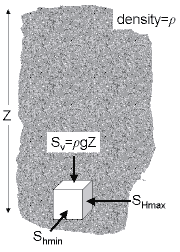You
are at
HF Introduction
|
The
in situ state of stress in the earth's crust has been widely recognized as a basic parameter necessary in the engineering
design of underground openings. Quantitative evaluation of
horizontal in situ stresses in rock at a specific site cannot
be made since gravitational forces are practically the only
one clearly understood. Therefore, these horizontal stresses
require direct measurements in the field. Presently the most
common method of measuring in situ stress from near-surface
to considerable depths is hydraulic fracturing (or hydrofrac).
recognized as a basic parameter necessary in the engineering
design of underground openings. Quantitative evaluation of
horizontal in situ stresses in rock at a specific site cannot
be made since gravitational forces are practically the only
one clearly understood. Therefore, these horizontal stresses
require direct measurements in the field. Presently the most
common method of measuring in situ stress from near-surface
to considerable depths is hydraulic fracturing (or hydrofrac).
Typically
hydraulic fracturing is conducted in vertical boreholes.
A short segment of the hole is sealed off using an straddle
packer. This is followed by the pressurization of the fracture-free
segment of the hole by pumping in water. The pressure is
raised until the rock surrounding the hole fails in tension
at a critical pressure. Following breakdown, the shut-in
pressure, the lowest test-interval pressure at which the
hydrofrac closes completely under the action of the stress
acting normal to the hydrofrac. In a vertical test hole
the hydrofrac is expected to be vertical and perpendicular
to the minimum horizontal stress.
|
|